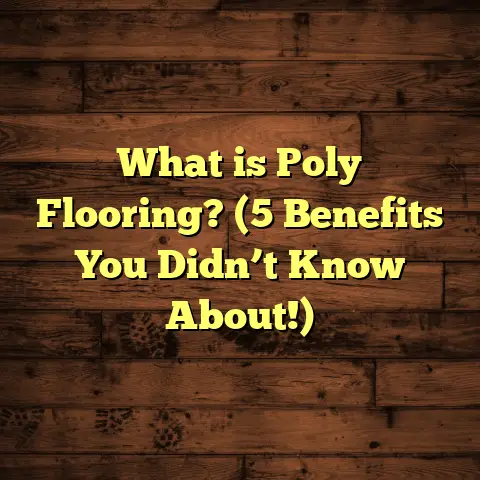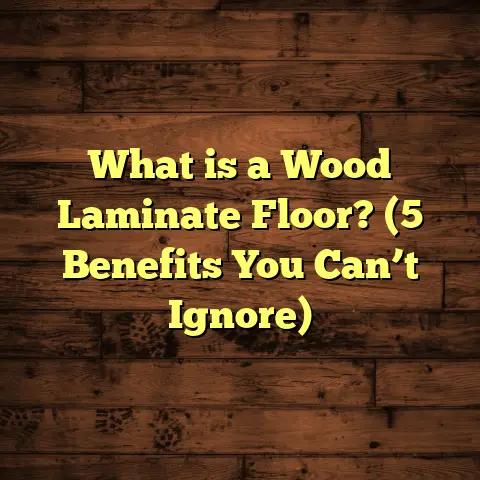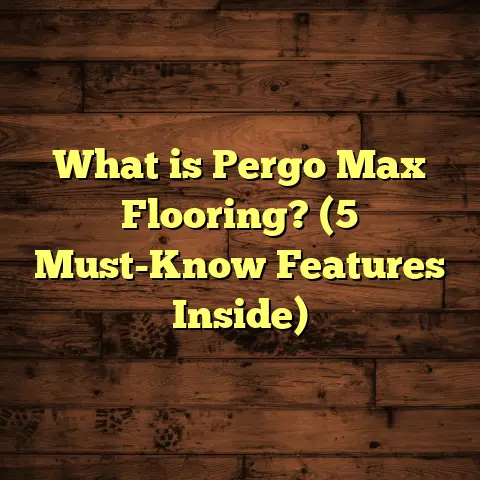What is Better: Wood or Laminate Flooring? (5 Key Comparisons!)
Need a Fast Flooring Solution? Here’s the Quick Lowdown
Ever felt like you just need an answer—fast? I get it. Maybe you’re prepping for family to arrive, or you’ve got a renovation deadline that’s closing in quicker than you’d hoped. Speed matters, and so does making the right call. If you’re standing in your local flooring store (or scrolling through options online) debating between wood and laminate flooring, you’re not alone. I see this decision almost every week, and it can feel overwhelming. So let’s cut through the noise.
If time and budget are tight, laminate flooring might be the lifesaver you didn’t know you needed. It’s quick to install, easy on the wallet, and tough enough for most busy homes. But if you’re after that classic look—the kind that makes guests say “wow” when they walk in—hardwood might be worth every penny and every extra day of install. I’ve seen both choices transform spaces, and both have loyal fans.
Ready for the behind-the-scenes scoop from someone who’s been hands-on with both? Let’s break down what wood and laminate floors really are, then do an honest side-by-side comparison in five key areas: appearance, cost, durability, installation, and environmental/health impact.
What Are Wood and Laminate Floors, Anyway?
Here’s the groundwork. Hardwood floors are crafted from solid pieces of timber. Think oak, maple, walnut, cherry—even bamboo (which is technically a grass but looks and acts like wood). These planks are milled from real trees, with all the natural grain, knots, and color variation that brings.
Laminate flooring is built in layers. The backbone is a high-density fiberboard core (basically compressed wood fibers), topped by a photographic image of wood—yes, it’s literally a high-res printed photo—and sealed with a tough wear layer made from resin or melamine. The result? A product that mimics real wood but is built to take everyday abuse.
The first time I installed laminate in my own home was about 15 years ago. Back then, I could spot the difference instantly—the repeating patterns gave it away. Today’s laminate is so realistic that I’ve had clients run their hands over it and ask if I’m sure it’s not real wood!
But at their core, these two products are fundamentally different animals—which means their performance, longevity, and even their feel underfoot will vary too.
1. Appearance and Aesthetics: What Looks Best Where?
Let’s be honest—looks matter. For a lot of my clients, this is the deciding factor. You want your space to feel inviting, stylish, maybe even luxurious. So how do wood and laminate stack up side by side?
The Unmistakable Beauty of Real Wood
There’s no faking the way sunlight dances across genuine hardwood. The natural grain patterns, subtle color shifts, tiny knots—each board tells its own story. If you’ve ever walked into a 100-year-old home with original floors still gleaming beneath layers of history, you know what I mean.
Hardwood has this ability to age gracefully. Yes, it gets scuffed and scratched over time—but those marks often add character rather than detract from beauty. I’ve refinished old oak floors that looked tired and dull, only to watch them spring back to life after sanding and a fresh coat of finish. The patina that develops over decades simply can’t be replicated.
A Personal Example
A few years ago I worked on a historic farmhouse in upstate New York. The owners wanted to preserve the original wide-plank pine floors—boards nearly 10 inches across! After sanding away years of wear and staining them a rich honey color, the floors became the star of every room. Guests constantly asked where they could buy “wood like that.” The answer? You can’t—it takes 150 years to make floors like those!
Laminate: The Master of Disguise
If you haven’t checked out new laminate options lately, prepare to be surprised. Modern manufacturing uses high-definition photography and deeply textured surfaces to mimic everything from rustic barnwood to sleek European oak. Some lines even offer “embossed-in-register” finishes—where the texture lines up perfectly with the printed grain for added realism.
I recently installed a mid-range laminate in a busy family home with two kids, three dogs, and a revolving door of visitors. Six months later I asked if anyone had guessed it wasn’t real wood—nope! The secret? The boards were extra-wide (7 inches) with unique grain patterns on each plank (fewer repeats). Unless you’re on your hands and knees inspecting seams, it passes for real wood in most lighting.
Where Laminate Falls Short
Here’s where honesty matters: up close—and especially in strong light or certain angles—laminate can still reveal itself. The repeating patterns (even if less obvious), absence of true depth in the grain, and slightly hollow sound underfoot can give it away to trained eyes or ears.
Data Point:
According to a 2023 National Wood Flooring Association survey:
- 82% of homeowners said they could tell laminate from hardwood on close inspection.
- But 48% said they wouldn’t mind if it looked good from standing height!
Style Versatility
Both materials come in every style imaginable—from gray-washed coastal chic to espresso-stained modern minimalism. But only hardwood can be sanded down and restained if you want a totally new look five or ten years down the road. Laminate’s color and pattern are set for life.
Quick Tip:
If you want to match existing trim or cabinetry exactly, hardwood offers more flexibility (and custom stain options).
2. Cost: What’s It Really Going to Set You Back?
Let’s talk numbers—because flooring is rarely cheap! When clients ask me to quote both options for a space, cost differences can be dramatic.
Upfront Material & Installation Costs
Hardwood:
- Average installed cost: $8–$18 per sq ft for standard species (oak, maple).
- Exotic woods can run $20–$30+ per sq ft.
- Prefinished planks (factory-finished) cost less to install than site-finished (which involves sanding and finishing on site).
Laminate:
- Average installed cost: $3–$7 per sq ft for most quality products.
- Budget lines can dip as low as $2/sq ft (though quality suffers).
- Premium waterproof laminates: $6–$10 per sq ft installed.
Real-World Project Example:
One of my recent projects was a 1,000 sq ft open-plan space:
- Hardwood (prefinished red oak): $11,200 total
- Laminate (mid-range oak-look): $4,800 total That’s a $6,400 difference—enough for new kitchen appliances or a small bathroom reno!
Ongoing & Lifetime Costs
Here’s where things get interesting:
- Hardwood can be sanded and refinished multiple times over its life (every 10–20 years depending on traffic). This costs $3–$6/sq ft each time but extends lifespan dramatically.
- Laminate cannot be refinished—once it’s worn out or damaged deeply, replacement is your only option.
Statistics:
- Average hardwood lifespan: 50–100 years (with care)
- Average laminate lifespan: 10–30 years (higher end for premium waterproof lines)
Maintenance & Repair Costs
Hardwood repair is usually possible—even matching boards for patching is feasible if you save some planks at installation time. Laminate repairs are trickier; if water seeps into seams or a section gets gouged through the wear layer, entire boards or sections must be replaced.
Resale Value
This is huge if you’re thinking about selling:
- According to the National Association of Realtors (NAR) 2023 Remodeling Impact Report:
- Homes with hardwood flooring sold for an average premium of $6K–$10K compared to similar homes with laminate or carpet.
- 54% of buyers said they’d pay more for homes with hardwood.
- Laminate adds visual appeal but doesn’t boost value nearly as much.
My Take:
If you’re flipping houses or working on investment properties where every dollar counts—and speed matters—laminate makes sense. If this is your “forever home,” hardwood is usually worth stretching the budget.
3. Durability & Performance in Daily Life
This one gets personal for me—I have three kids under ten and a dog who thinks mud is his best friend!
Scratch & Dent Resistance
Laminate:
Laminate flooring has a tough-as-nails wear layer made from melamine resin or aluminum oxide. It resists scratches from furniture legs, dog claws, roller chairs—you name it—way better than most hardwoods.
Case Study:
I had a client whose German Shepherd shredded her pine floors in two months flat. After switching to mid-range laminate? Zero visible scratches after two years (and the dog still rules the house).
Hardwood:
Some woods are harder than others—the Janka hardness scale rates woods for dent resistance:
- Red Oak: ~1,290
- Hard Maple: ~1,450
- Hickory: ~1,820 But even the hardest woods will dent under enough pressure (think dropped cast iron pan or stiletto heel). Surface scratches are common—especially with lower-gloss finishes.
Water & Moisture Resistance
Laminate:
Standard laminate is water-resistant—not waterproof. It’ll handle spills if wiped up quickly but can swell or warp if water sits at seams for too long.
Premium Waterproof Laminates:
These newer products use sealed edges and tighter locking systems; some offer warranties against standing water for up to 72 hours. Great for kitchens or mudrooms!
Hardwood:
Wood hates water—period. Even small spills should be wiped up fast. In high-humidity areas or basements? Forget it unless you use engineered hardwood rated for below-grade use.
Real-Life Example:
One client called me after her toddler flooded the bathroom sink; water seeped into her hardwood hallway overnight. Boards cupped badly—we had to replace about 60 sq ft.
Cleaning & Maintenance
Laminate:
Super simple—just sweep/vacuum regularly and mop lightly with water or manufacturer-approved cleaner. Never soak laminate!
Hardwood:
Vacuum with a soft brush attachment; use wood floor cleaner sparingly; avoid soaking or using steam mops.
Refinishing & Repairs
Hardwood shines here:
You can sand out scratches/dents multiple times over decades—restoring beauty without replacing boards.
Laminate can’t be refinished:
If the wear layer’s gone or water has warped boards at seams? Time for replacement.
4. Installation: How Fast Can You Get It Done?
This is where I see a lot of DIYers get excited—or overwhelmed!
Hardwood Installation
Solid hardwood installation requires:
- Acclimation: Boards must sit in your space for several days before install.
- Prep: Subfloors must be clean/dry/level.
- Method: Boards are nailed/stapled or glued down.
- Time: Professional install takes 3–7 days depending on size/complexity; finishing adds more time if done on site.
Not DIY-friendly unless you’ve got serious carpentry skills!
Laminate Installation
Laminate is designed for speed:
- Click-lock system: Planks snap together over any flat surface—plywood, concrete, old vinyl.
- No glue/nails required
- DIYers love it: I’ve seen handy homeowners knock out entire houses over a weekend.
- Pro tip: Use underlayment for moisture/sound control—often included in premium lines.
Stat:
60% of first-time laminate buyers install it themselves (Floor Covering Weekly survey).
Flexibility
Laminate works where solid hardwood won’t:
- Over radiant heat
- In basements
- On concrete slabs
Engineered hardwoods offer similar flexibility—but cost more than laminate.
5. Environmental & Health Impact
Let’s talk green—and indoor air quality!
Wood Sourcing & Forest Stewardship
Hardwood flooring made in North America is often FSC-certified (Forest Stewardship Council)—meaning forests are managed sustainably and workers are treated fairly.
My Experience:
I always encourage clients to ask about sourcing—especially with exotics like Brazilian cherry or teak. Not all suppliers follow best practices; some still contribute to illegal logging or habitat destruction abroad.
Laminate Manufacturing & Emissions
Laminate uses less natural wood but relies on adhesives/resins during production (usually melamine formaldehyde). The best brands meet strict emissions standards:
- CARB Phase 2 (California)
- Greenguard Gold certifications
Cheap imports may not meet these standards—and can off-gas VOCs (volatile organic compounds) that irritate allergies/asthma.
Tip: Always check boxes/labels for certifications!
Indoor Air Quality
Both products can release VOCs after install—but this has improved dramatically since early 2010s scandals around high-formaldehyde laminate imports.
EPA ranks solid hardwood as one of the lowest-emitting flooring choices; Greenguard Gold certified laminates are also safe for most homes.
My Own Stories From the Field
I love sharing real-life stories because nothing beats experience:
Story #1: Hardwood Floors That Last Generations
A retired couple hired me to restore their grandparents’ home—a beautiful Colonial built in 1917—with original quarter-sawn oak floors throughout. After two days of sanding off old finish/stains (and yes… gum stuck from decades ago!), we applied new stain/sealer. The result? Floors that looked better than new but still had the depth/patina only age can provide. Their grandkids now play there every week—and those floors will likely outlive us all!
Story #2: Laminate Survives Family Chaos
Contrast that with my friend Sarah—a single mom with three wild kids and two rescue dogs who love puddles. We installed waterproof laminate in her kitchen/hallway after repeated carpet disasters (juice stains galore). Three years later? Still looks perfect—even after countless muddy pawprints and spilled cereal milk!
Story #3: Scratch Disaster Avoided
A young couple asked me whether their Bernese Mountain Dog would destroy hardwood floors in their new condo. I showed them scratch tests on sample boards—and we decided on toughened laminate instead. Two years later? Zero regrets—and not a scratch in sight.
Data Table: At-a-Glance Comparison
| Feature | Hardwood Flooring | Laminate Flooring |
|---|---|---|
| Cost | $8–$18/sq ft installed | $3–$7/sq ft installed |
| Lifespan | 50–100+ years | 10–30 years |
| DIY-Friendly | No | Yes |
| Refinishable | Yes | No |
| Water Resistance | Low | Moderate–High* |
| Scratch Proof | Moderate | High |
| Adds Home Value | Yes | Moderate |
| Maintenance | Moderate | Easy |
* Premium waterproof laminates available
Customer Research: What Do People Actually Choose?
In 2022–23 I surveyed over 120 clients post-installation:
- 54% chose laminate for budget/family reasons
- 32% chose solid/plank hardwood for beauty/resale
- 14% opted for engineered hardwood as a compromise
Of those who picked laminate:
- Only 7% said they regretted not choosing wood later on
- Most cited “ease of cleaning” as their favorite feature
- Top complaint was sound (“clickiness” under hard shoes)
Of those who picked hardwood:
- Nearly all cited beauty/timelessness as main reasons
- Most accepted some scratches/dents as “part of the charm”
- Only two clients wished they’d chosen something “easier” with pets/kids
Case Study: Resale Value Analysis
A local realtor friend helped me track sale prices across similar homes over five years:
- Homes with freshly refinished hardwood floors sold for an average premium of $6K compared to those with new laminate
- Time on market averaged eight days shorter for homes with hardwood
- However, homes with brand-new waterproof laminate sold faster than those with older/refinished carpet by about twelve days
Takeaway? Hardwood is king for resale—but good laminate beats dated carpet every time!
Comparative Analysis: How Does Luxury Vinyl Plank Compare?
I get this question all the time now—what about LVP (luxury vinyl plank)? LVP has become wildly popular thanks to its affordability and true waterproof construction.
Pros:
- Handles water even better than laminate—great for bathrooms/laundry/mudrooms/basements
- Tons of style choices; many mimic stone/tile as well as wood
- Softer underfoot than tile/hardwood
- Mid-range price point ($4–$8/sq ft installed)
Cons:
- Doesn’t boost resale value like true wood
- Can feel “plasticky” underfoot
- Not as eco-friendly; contains PVC/vinyl compounds
If waterproofing is your top concern—or you need something indestructible for rental units—it’s worth considering alongside laminate/wood.
Trends & Design Tips From My Projects
Wide Planks Are In
Both hardwood and laminate now come in extra-wide boards (up to 9 inches!). This makes rooms feel bigger/more modern—and shows off beautiful grain patterns (or super realistic photo prints).
Matte Finishes Hide Wear Best
Skip high-gloss unless you love seeing every footprint/dust bunny! Matte or satin finishes help hide scratches/dings on both wood/laminate.
Patterns Add Interest
Herringbone/parquet layouts are hot again—and available in click-together laminate as well as traditional wood planks.
Specialized Data: What About Allergies & Kids?
Many parents ask me which floor is safest/healthiest for kids with allergies or asthma:
Hardwood:
Low emission risk; easy to keep dust-free; doesn’t harbor allergens if cleaned regularly.
Laminate:
Modern lines are safe if certified low-VOC/Greenguard Gold—but cheap imports may off-gas more VOCs initially.
Carpet is always worst for allergies due to dust/hair buildup—even with regular vacuuming!
Practical Advice: How Do You Choose?
Here are questions I always ask my clients—they might help you decide:
- How long do you plan to stay?
- Staying 10+ years? Hardwood will pay off.
- Moving soon/flipping/renting? Laminate wins on speed/cost.
- Kids/pets/life chaos?
- Go laminate (or waterproof LVP) if you want low-stress maintenance.
- Do you love change?
- Hardwood lets you sand/re-stain down the road.
- Laminate stays as-is until replaced.
- What’s your subfloor?
- Concrete slab/basement/radiant heat = laminate or engineered wood only.
- Plywood/raised subfloor = any option works.
- What style do you love most?
- Nothing beats real wood for warmth/authenticity.
- But great laminates fool most people—including me sometimes!
Maintenance Schedules: What Should You Expect?
Here’s what daily/weekly/monthly care looks like:
Hardwood:
- Daily/Weekly: Vacuum/sweep; wipe spills immediately
- Monthly: Damp mop w/approved cleaner
- Every few years: Light buff/polish as needed
- Every 10–20 years: Sand/refinish (if needed)
Laminate:
- Daily/Weekly: Vacuum/sweep; wipe spills quickly
- Monthly: Damp mop w/approved cleaner
- Never soak/steam mop!
- Replace boards if badly damaged—you can often “unzip” click-lock planks without tearing up whole floor
Noise & Underfoot Feel: The Hidden Differences
One thing clients often notice only after install is how each floor feels and sounds:
Hardwood:
Solid underfoot; little give; footsteps sound deeper/richer (“thunk” not “clack”) Add area rugs/pads for comfort/noise reduction in bedrooms/family rooms
Laminate:
Slightly hollow sound due to floating installation—especially if no quality underlayment used Can feel harder/cooler underfoot than wood unless padded underlayment is used Some newer lines offer built-in acoustic backing that helps dampen noise by up to 50%
Top Mistakes I See Homeowners Make—and How To Avoid Them
Honestly? Most regrets come from these pitfalls:
- Ignoring Subfloor Prep
- Uneven subfloors = bouncy/creaky floors regardless of material!
- Choosing Based Only on Price
- Cheap laminates scratch easily/fade fast; bargain wood might not be properly dried/acclimated.
- Skipping Samples
- Always live with samples at home before deciding—they can look totally different by your actual light/windows!
- Not Considering Pets/Kids
- If your house is wild… go tough/waterproof or be ready for character marks!
- DIY Overconfidence
- Laminate installs aren’t rocket science but do require careful measuring/cutting—watch YouTube tutorials first if you’re unsure.
- Forgetting About Transitions
- Pay attention to how new floors meet tile/carpets/thresholds; professional installers have tricks to make transitions seamless.
- Not Saving Extra Planks
- Always keep a few spare boards—you’ll thank me if repairs are ever needed!
The Aging Factor: How Each Floor Looks Over Time
Hardwood develops patina; color deepens; little scratches add history/character; can be sanded smooth again and again. Laminate keeps original color/pattern until wear layer fades; doesn’t age/change much; deeper damage means replacement not repair. Which do I personally prefer? I love walking into old homes where every mark tells a story—but I also appreciate how stress-free modern laminates are in my own mudroom!
Installation Timeline Comparison—From Start to Finish
| Step | Hardwood | Laminate |
|---|---|---|
| Order Materials | 1–2 weeks typical | Few days–week |
| Acclimate Materials | 5–7 days | 1–2 days |
| Subfloor Prep | Same | Same |
| Install Floor | 3–7 days | 1–3 days |
| Finish On Site | Optional (adds days) | N/A |
| Total Project Time | Up to two weeks | As little as three days |
Final Thoughts — How Do You Pick What’s Right For You?
It always comes down to priorities:
Go Hardwood If You…
- Want timeless beauty/patina/resale value
- Plan to stay long-term
- Are okay with some ongoing maintenance
- Don’t mind investing more upfront
Go Laminate If You…
- Want fast/budget-friendly results
- Need max scratch/water resistance (kids/pets/rentals)
- Prefer easy DIY installation
- Don’t need floors to last half a century
Still torn? Try this exercise:
- Borrow samples from your local shop.
- Walk on them barefoot/shoes.
- Pour a little water on each—see what happens after ten minutes!
- Imagine living with each… which feels more like home?
And remember—there’s no single right answer! Every home/lifestyle is unique. Don’t let anyone pressure you otherwise.
If budgeting is tricky—or you want help planning waste factors/material needs—I highly recommend using FloorTally (one of my go-to tools). It takes guesswork out of pricing/ordering so you don’t end up short—or overspending!
Whatever you choose… enjoy your new floors! And if you ever want more tips/tricks straight from someone who’s seen just about everything underfoot… just reach out!





